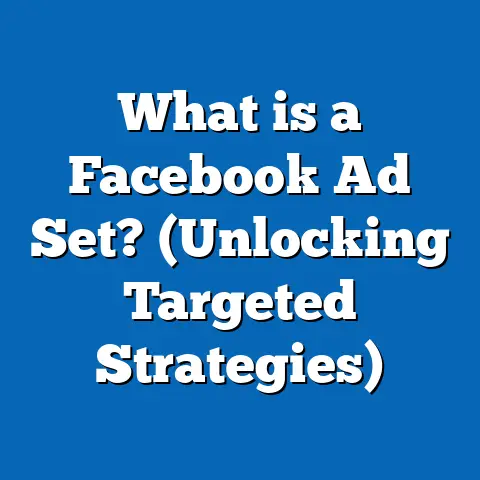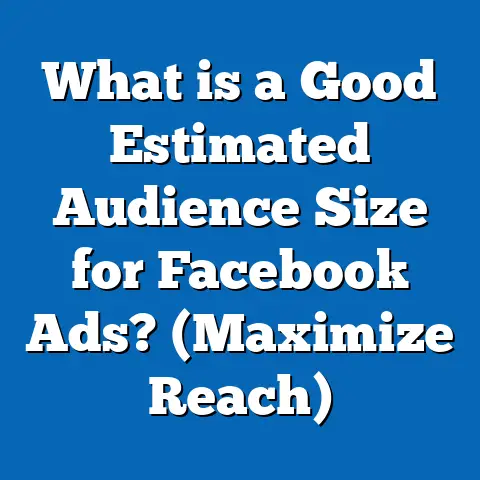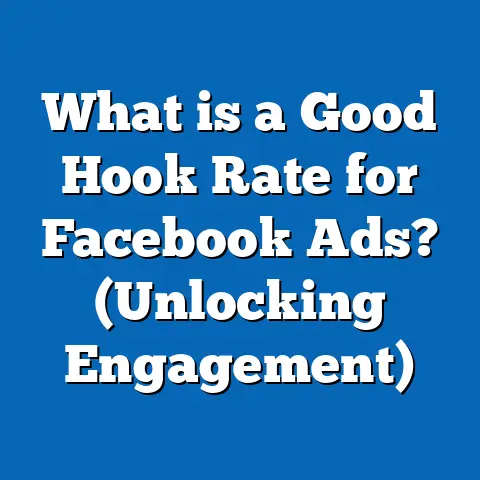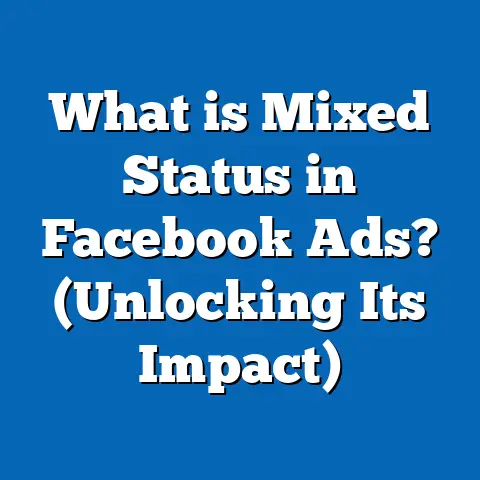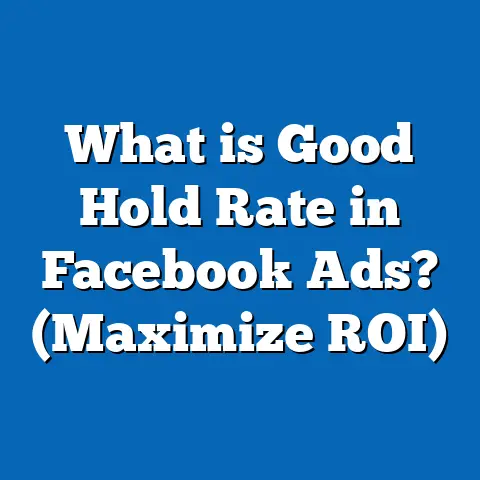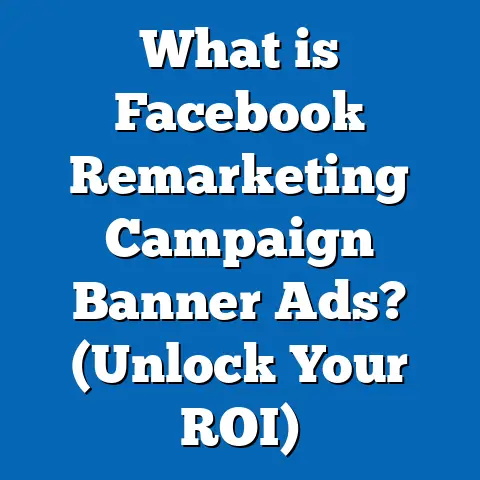What is the Ideal Duration for Facebook Ads? (Maximize Impact)
What is the Ideal Duration for Facebook Ads? (Maximize Impact)
Have you ever wondered how long your Facebook ads should run to get the best results? Setting the right duration for your Facebook ad campaigns is a critical factor in maximizing your advertisement impact, optimizing your budget, and achieving your marketing goals. But what does “ideal duration” really mean, and how can you determine it for your unique campaign needs?
This guide breaks down every aspect of Facebook ad duration—from fundamental concepts to advanced strategies. You’ll learn how duration affects ad performance, backed by data and real-world case studies. By the end, you’ll have actionable insights to maximize your ad effectiveness on Facebook.
Why Does Facebook Ad Duration Matter?
Before diving into numbers and recommendations, it’s essential to understand why ad duration plays such a pivotal role in campaign success.
- Audience Exposure: The duration determines how often and how many times your target audience sees your ad.
- Ad Fatigue: Repeated exposure to the same ad can cause declining engagement.
- Algorithm Learning: Facebook’s delivery system requires sufficient data over time to optimize ad placements.
- Budget Utilization: Duration influences how your budget is spent daily and overall campaign pacing.
Audience Exposure and Frequency
Frequency refers to the average number of times a single user sees your ad. According to Facebook, an ideal frequency range is typically between 1.8 and 3.0 for most campaigns. If your ads run too long without variation, frequency can spike beyond this range, leading to ad fatigue where users start ignoring or even negatively reacting to your ads.
Ad Fatigue Explained
Ad fatigue occurs when your audience sees the same creative repeatedly, causing a decline in Performance Metrics like CTR (Click-Through Rate) and ROAS (Return on Ad Spend). Facebook’s algorithm detects this drop and may reduce delivery, increasing your cost per result.
The Learning Phase
Facebook ads enter a “learning phase” when they are newly launched or significantly edited. During this phase, the algorithm explores optimal ways to deliver your ads by gathering data based on your campaign objective (e.g., conversions or traffic). The learning phase requires approximately 50 optimization events (such as purchases or leads) within 7 days for the algorithm to stabilize.
If the campaign runs too short or if too many changes are made frequently, it may never exit this phase, resulting in inefficient spending.
How Long Should Facebook Ads Run? Data-Driven Insights
Determining the ideal duration depends heavily on campaign goals, industry, audience size, and budget. Let’s look into detailed data points and research findings that clarify these relationships.
Key Statistics
- A WordStream study analyzed over 256 million impressions and found that ads running between 7 and 14 days consistently achieve the highest engagement rates, often 20-30% better than longer durations.
- According to Facebook’s internal data, most campaigns experience a dip in engagement after around 10-14 days due to ad fatigue.
- AdEspresso case study showed that campaigns exceeding 21 days without creative refreshes see a 25% or more drop in CTR.
- HubSpot research indicates that shorter campaigns with frequent creative updates outperform longer static campaigns by up to 40% in conversion rates.
Case Study: E-commerce Campaign
A mid-sized e-commerce brand ran identical Facebook ads with two different durations:
- Campaign A ran for 10 days with fresh creatives rotated every 3 days.
- Campaign B ran for 30 days with no creative changes.
Results:
- Campaign A had a CTR of 2.5% and ROAS of 6.5.
- Campaign B’s CTR dropped from 2.3% on day 5 to 1.2% by day 25, with ROAS falling below 3.0 by day 20.
This case illustrates how shorter, dynamic campaigns help maintain engagement and maximize return.
Factors Influencing Ideal Ad Duration
Campaign Objectives
Your campaign goal heavily influences the ideal ad length.
- Brand Awareness: Longer durations (14-21 days) work well because repeated exposure builds recall.
- Lead Generation: Medium lengths (7-14 days) balance urgency with enough time to nurture leads.
- Conversions/Sales: Short bursts (5-10 days) focused on optimization and creative testing usually generate better ROI.
Audience Size and Composition
- Large audiences tolerate longer campaigns since frequency growth is slower.
- Narrow or remarketing audiences require shorter durations or more frequent creative refreshes due to faster frequency increase.
Budget Considerations
Higher budgets can sustain longer campaigns with sufficient daily spend to exit the learning phase quickly. Smaller budgets benefit from shorter bursts that focus spend efficiently.
Industry Variations
- Fast-moving consumer goods often benefit from shorter campaigns aligned with trends or sales events.
- Service industries may require longer durations to build trust and nurture leads.
Breaking Down Duration by Campaign Type
1. Awareness Campaigns
For awareness-focused ads aiming to reach new audiences:
- Typical duration: 14 to 21 days
- Goal: Maximize reach and frequency without causing fatigue
- Strategy: Rotate creatives every 7 days; use broader targeting
- Example: A beverage company launching a new product might run a three-week awareness campaign with video ads refreshed weekly.
2. Traffic Campaigns
Driving traffic to websites or landing pages requires:
- Typical duration: 7 to 14 days
- Goal: Optimize delivery for clicks; gather data quickly
- Strategy: Use click-focused bidding; refresh creatives every 5–7 days
- Example: An online course provider promoting free webinars might run two-week traffic campaigns rotating ad copies.
3. Conversion Campaigns
Optimizing for sales or specific actions demands precision:
- Typical duration: 5 to 10 days
- Goal: Exit learning phase fast; optimize ROAS
- Strategy: Launch multiple ad sets; monitor performance daily; pause underperformers
- Example: An apparel retailer pushing a flash sale might run a one-week conversion campaign with aggressive bidding.
4. Retargeting Campaigns
Retargeting ads target warmer audiences who interacted before:
- Typical duration: 5 to 14 days
- Goal: Nurture leads without oversaturating
- Strategy: Use dynamic creatives; cap frequency at 3
- Example: An online service retargeting website visitors might run rolling two-week retargeting campaigns refreshing creatives weekly.
How to Monitor and Adjust Ad Duration Effectively
Key Metrics to Track
- Frequency: Aim for 1.8 – 3; pause or refresh creatives if it exceeds.
- CTR: Declining CTR usually signals fatigue.
- Cost per Result: Rising cost indicates reduced efficiency.
- Relevance Score / Quality Ranking: Dropping scores suggest ads aren’t resonating anymore.
Best Practices for Adjustment
- Set Mid-Campaign Checkpoints: Review metrics at day 5, day 10, and adjust accordingly.
- Creative Refresh: Change images, videos, or copy every 7–10 days depending on duration.
- Audience Segmentation: Break audiences into smaller groups for targeted messaging and staggered schedules.
- Budget Reallocation: Shift budget from underperforming ad sets or campaigns to top performers.
- A/B Testing: Run simultaneous short-duration tests with different creatives or targeting to identify winning approaches quickly.
Comparison with Other Advertising Platforms
Google Ads vs. Facebook Ads Duration
Google Ads generally allows longer-running campaigns because its search intent-driven model delivers ads based on queries rather than repeat exposure. Performance depends heavily on keyword quality rather than frequency management.
Facebook Ads require more active management of ad duration due to their social feed format that emphasizes visual freshness and audience engagement.
TikTok Ads Duration
TikTok shares similarities with Facebook in terms of visual appeal but trends move faster on TikTok. Effective TikTok campaigns often run shorter durations (3–7 days) with very frequent creative refreshes compared to Facebook’s typical ranges.
Advanced Strategies for Maximizing Ad Duration Impact
Sequential Advertising
Use sequential storytelling by running a series of ads over multiple weeks. For example:
- Week 1: Awareness ad introducing product benefits.
- Week 2: Engagement ad asking users to interact or comment.
- Week 3: Conversion-focused offer targeting engaged users.
This method uses longer total duration effectively without causing fatigue on any single creative.
Automated Rules & Dynamic Creative Optimization
Leverage Facebook’s automated rules to pause ads when frequency exceeds thresholds or cost per result rises beyond limits. Use Dynamic Creative Ads that automatically test combinations of headlines, images, and CTAs to keep content fresh during longer campaigns.
Seasonal & Event-Based Adjustments
Adjust ad duration based on seasonality or events like holidays or product launches. For instance:
- Black Friday campaigns may be short but highly intense (3–7 days).
- New product launches may require extended awareness periods (21+ days).
Frequently Asked Questions About Facebook Ad Duration
How often should I change my ad creatives?
Every 7–10 days is a good rule of thumb depending on campaign length and audience size. Smaller audiences require more frequent changes.
Can I run an ad indefinitely?
While possible, indefinite running without changes usually leads to ad fatigue and reduced performance unless you continuously refresh creatives and targeting.
What if my campaign is not exiting the learning phase?
Try increasing budget slightly or extending campaign duration while minimizing edits during this time.
Conclusion: Best Practices for Facebook Ad Duration
- Match duration with campaign goals: Short bursts for conversions, longer for awareness.
- Monitor key metrics daily: Frequency, CTR, cost per result.
- Refresh creatives regularly: Ideally every 7–10 days.
- Use data-driven decisions: Adjust duration based on real-time performance.
- Segment audiences smartly: Different durations for cold vs. warm audiences.
By carefully planning your Facebook ad campaign duration according to these insights and adapting based on ongoing results, you ensure maximum impact while optimizing spend efficiency.
If you want personalized advice tailored to your business type or specific goals, feel free to ask!
Would you like me to provide templates or tools for managing Facebook ad durations effectively?

